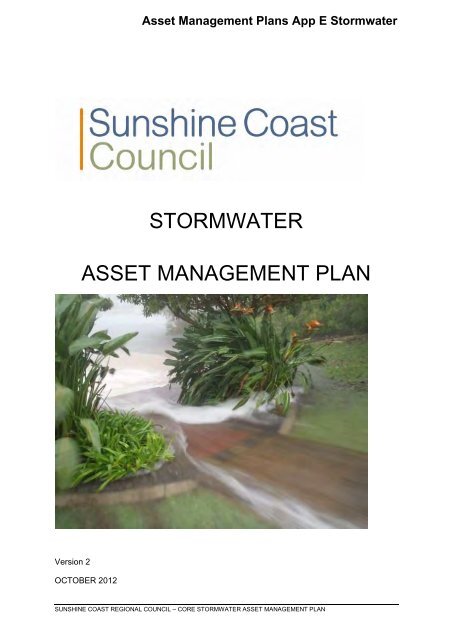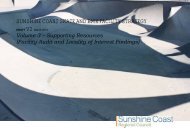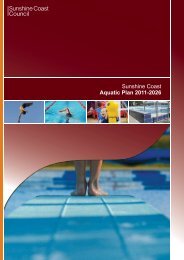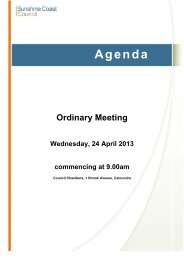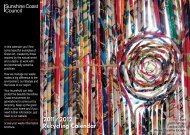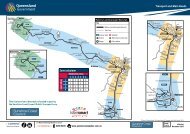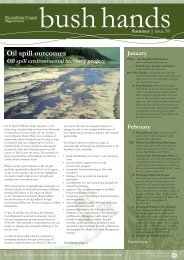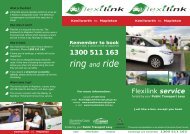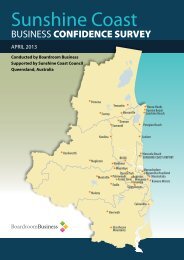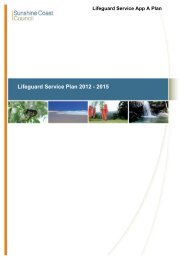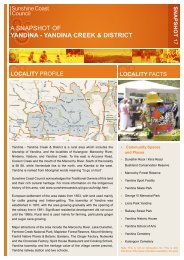stormwater asset management plan - Sunshine Coast Council
stormwater asset management plan - Sunshine Coast Council
stormwater asset management plan - Sunshine Coast Council
Create successful ePaper yourself
Turn your PDF publications into a flip-book with our unique Google optimized e-Paper software.
Asset Management Plans App E Stormwater<br />
STORMWATER<br />
ASSET MANAGEMENT PLAN<br />
Version 2<br />
OCTOBER 2012<br />
SUNSHINE COAST REGIONAL COUNCIL – CORE STORMWATER ASSET MANAGEMENT PLAN
Asset Management Plans App E Stormwater<br />
TABLE OF CONTENTS<br />
ABBREVIATIONS ................................................................................................................................................................................... i<br />
GLOSSARY............................................................................................................................................................................................ ii<br />
1. EXECUTIVE SUMMARY........................................................................................................................................................... 1<br />
What <strong>Council</strong> Provides..................................................................................................1<br />
What does it Cost? ......................................................................................................2<br />
Next Steps.................................................................................................................2<br />
2. INTRODUCTION ....................................................................................................................................................................... 3<br />
2. INTRODUCTION ....................................................................................................................................................................... 4<br />
2.1 Background .....................................................................................................4<br />
2.2 Goals and Objectives of Asset Management ...................................................6<br />
2.3 Plan Framework ..............................................................................................7<br />
2.4 Core and Advanced Asset Management..........................................................8<br />
3. LEVELS OF SERVICE............................................................................................................................................................ 10<br />
3.1 Customer Research and Expectations........................................................... 10<br />
3.2 Legislative Requirements .............................................................................. 10<br />
3.3 Current Levels of Service .............................................................................. 11<br />
3.4 Desired Levels of Service .............................................................................. 13<br />
4. FUTURE DEMAND ................................................................................................................................................................. 14<br />
4.1 Demand Forecast .......................................................................................... 14<br />
4.2 Changes in Technology ................................................................................. 14<br />
4.3 Demand Management Plan ........................................................................... 15<br />
4.4 New Assets from Growth ............................................................................... 16<br />
5. LIFECYCLE MANAGEMENT PLAN....................................................................................................................................... 18<br />
5.1 Background Data........................................................................................... 18<br />
5.1.1 Physical parameters .............................................................................. 18<br />
5.1.2 Asset capacity and performance............................................................ 21<br />
5.1.3 Asset condition ...................................................................................... 22<br />
5.1.4 Asset valuations..................................................................................... 22<br />
5.2 Risk Management Plan.................................................................................. 22<br />
5.3 Routine Maintenance Plan............................................................................. 23<br />
5.3.1 Maintenance <strong>plan</strong>................................................................................... 23<br />
5.3.5 Standards and specifications ................................................................. 25<br />
5.3.6 Summary of future maintenance expenditures ....................................... 25<br />
5.4 Renewal/Replacement Plan........................................................................... 26<br />
5.4.1 Rehabilitation/Renewal Strategies ......................................................... 26<br />
5.4.2 Current Activities.................................................................................... 26<br />
5.4.3 Renewal <strong>plan</strong> ......................................................................................... 27<br />
5.4.2 Renewal standards ................................................................................ 28<br />
5.4.3 Summary of future renewal expenditure................................................. 28<br />
5.5 Creation/Acquisition/Upgrade Plan ................................................................ 29<br />
5.5.1 Creation/Acquisition/Augmentation Strategies ....................................... 29<br />
5.5.2 Current Activities.................................................................................... 29<br />
5.5.3 Summary of Creation/Acquisition/Augmentation Costs .......................... 29<br />
5.5.4 Selection criteria .................................................................................... 30<br />
5.5.5 Standards and specifications ................................................................. 31<br />
5.5.6 Summary of future upgrade/new <strong>asset</strong>s expenditure ............................. 31<br />
5.6 Disposal Plan ................................................................................................ 32<br />
6. FINANCIAL SUMMARY.......................................................................................................................................................... 33<br />
6.1 Financial Statements and Projections............................................................ 33<br />
6.1.1 Sustainability of service delivery ............................................................ 33<br />
6.2 Funding Strategy ........................................................................................... 35<br />
6.3 Valuation Forecasts....................................................................................... 35<br />
6.4 Key Assumptions made in Financial Forecasts.............................................. 38<br />
7. ASSET MANAGEMENT PRACTICES.................................................................................................................................... 39<br />
SUNSHINE COAST REGIONAL COUNCIL – CORE STORMWATER ASSET MANAGEMENT PLAN
Asset Management Plans App E Stormwater<br />
7.1 Accounting/Financial Systems ....................................................................... 39<br />
7.2 Asset Management Systems ......................................................................... 39<br />
7.3 Information Flow Requirements and Processes............................................. 39<br />
7.4 Standards and Guidelines ............................................................................. 39<br />
7.5 Sustainability ................................................................................................. 40<br />
8. PLAN IMPROVEMENT AND MONITORING.......................................................................................................................... 41<br />
8.1 Performance Measures ................................................................................. 41<br />
8.2 Improvement Plan ......................................................................................... 41<br />
8.3 Monitoring and Review Procedures ............................................................... 43<br />
REFERENCES...................................................................................................................................................................................... 44<br />
SUNSHINE COAST REGIONAL COUNCIL – CORE STORMWATER ASSET MANAGEMENT PLAN
Asset Management Plans App E Stormwater<br />
- i -<br />
ABBREVIATIONS<br />
AAAC<br />
AMP<br />
ARI<br />
BOD<br />
CRC<br />
CWMS<br />
DA<br />
DoH<br />
EF<br />
GPT<br />
IRMP<br />
IPWEA<br />
LCC<br />
LCE<br />
MMS<br />
PCI<br />
RV<br />
SS<br />
vph<br />
Average annual <strong>asset</strong> consumption<br />
Asset <strong>management</strong> <strong>plan</strong><br />
Average recurrence interval<br />
Biochemical (biological) oxygen demand<br />
Current replacement cost<br />
Community wastewater <strong>management</strong> systems<br />
Depreciable amount<br />
Department of Health<br />
Earthworks/formation<br />
Gross Pollutant Trap<br />
Infrastructure risk <strong>management</strong> <strong>plan</strong><br />
Institute of Public Works Engineers, Australia<br />
Life Cycle cost<br />
Life cycle expenditure<br />
Maintenance <strong>management</strong> system<br />
Pavement condition index<br />
Residual value<br />
Suspended solids<br />
Vehicles per hour<br />
SUNSHINE COAST REGIONAL COUNCIL – CORE STORMWATER ASSET MANAGEMENT PLAN
Asset Management Plans App E Stormwater<br />
- ii -<br />
GLOSSARY<br />
Annual service cost (ASC)<br />
An estimate of the cost that would be tendered, per<br />
annum, if tenders were called for the supply of a service<br />
to a performance specification for a fixed term. The<br />
Annual Service Cost includes operating, maintenance,<br />
depreciation, finance/ opportunity and disposal costs,<br />
less revenue.<br />
Asset class<br />
Grouping of <strong>asset</strong>s of a similar nature and use in an<br />
entity's operations (AASB 166.37).<br />
Asset condition assessment<br />
The process of continuous or periodic inspection,<br />
assessment, measurement and interpretation of the<br />
resultant data to indicate the condition of a specific <strong>asset</strong><br />
so as to determine the need for some preventative or<br />
remedial action.<br />
Asset <strong>management</strong><br />
The combination of <strong>management</strong>, financial, economic,<br />
engineering and other practices applied to physical<br />
<strong>asset</strong>s with the objective of providing the required level<br />
of service in the most cost effective manner.<br />
Assets<br />
Future economic benefits controlled by the entity as a<br />
result of past transactions or other past events<br />
(AAS27.12).<br />
Property, <strong>plan</strong>t and equipment including infrastructure<br />
and other <strong>asset</strong>s (such as furniture and fittings) with<br />
benefits expected to last more than 12 month.<br />
Average annual <strong>asset</strong> consumption (AAAC)*<br />
The amount of a local government’s <strong>asset</strong> base<br />
consumed during a year. This may be calculated by<br />
dividing the Depreciable Amount (DA) by the Useful Life<br />
and totalled for each and every <strong>asset</strong> OR by dividing the<br />
Fair Value (Depreciated Replacement Cost) by the<br />
Remaining Life and totalled for each and every <strong>asset</strong> in<br />
an <strong>asset</strong> category or class.<br />
Brownfield <strong>asset</strong> values**<br />
Asset (re)valuation values based on the cost to replace<br />
the <strong>asset</strong> including demolition and restoration costs.<br />
Capital expansion expenditure<br />
Expenditure that extends an existing <strong>asset</strong>, at the same<br />
standard as is currently enjoyed by residents, to a new<br />
group of users. It is discretional expenditure, which<br />
increases future operating, and maintenance costs,<br />
because it increases council’s <strong>asset</strong> base, but may be<br />
associated with additional revenue from the new user<br />
group, eg. extending a drainage or road network, the<br />
provision of an oval or park in a new suburb for new<br />
residents.<br />
Capital expenditure<br />
Relatively large (material) expenditure, which has<br />
benefits, expected to last for more than 12 months.<br />
Capital expenditure includes renewal, expansion and<br />
upgrade. Where capital projects involve a combination of<br />
renewal, expansion and/or upgrade expenditures, the<br />
total project cost needs to be allocated accordingly.<br />
Capital funding<br />
Funding to pay for capital expenditure.<br />
Capital grants<br />
Monies received generally tied to the specific projects for<br />
which they are granted, which are often upgrade and/or<br />
expansion or new investment proposals.<br />
Capital investment expenditure<br />
See capital expenditure definition<br />
Capital new expenditure<br />
Expenditure which creates a new <strong>asset</strong> providing a new<br />
service to the community that did not exist beforehand.<br />
As it increases service potential it may impact revenue<br />
and will increase future operating and maintenance<br />
expenditure.<br />
Capital renewal expenditure<br />
Expenditure on an existing <strong>asset</strong>, which returns the<br />
service potential or the life of the <strong>asset</strong> up to that which it<br />
had originally. It is periodically required expenditure,<br />
relatively large (material) in value compared with the<br />
value of the components or sub-components of the <strong>asset</strong><br />
being renewed. As it reinstates existing service potential,<br />
it has no impact on revenue, but may reduce future<br />
operating and maintenance expenditure if completed at<br />
the optimum time, eg. resurfacing or resheeting a<br />
material part of a road network, replacing a material<br />
section of a drainage network with pipes of the same<br />
capacity, resurfacing an oval. Where capital projects<br />
involve a combination of renewal, expansion and/or<br />
upgrade expenditures, the total project cost needs to be<br />
allocated accordingly.<br />
Capital upgrade expenditure<br />
Expenditure, which enhances an existing <strong>asset</strong> to<br />
provide a higher level of service or expenditure that will<br />
increase the life of the <strong>asset</strong> beyond that which it had<br />
originally. Upgrade expenditure is discretional and often<br />
does not result in additional revenue unless direct user<br />
charges apply. It will increase operating and<br />
maintenance expenditure in the future because of the<br />
increase in the council’s <strong>asset</strong> base, eg. widening the<br />
sealed area of an existing road, replacing drainage pipes<br />
with pipes of a greater capacity, enlarging a grandstand<br />
at a sporting facility. Where capital projects involve a<br />
combination of renewal, expansion and/or upgrade<br />
expenditures, the total project cost needs to be allocated<br />
accordingly.<br />
Carrying amount<br />
SUNSHINE COAST REGIONAL COUNCIL – CORE STORMWATER ASSET MANAGEMENT PLAN
Asset Management Plans App E Stormwater<br />
- iii -<br />
The amount at which an <strong>asset</strong> is recognised after<br />
deducting any accumulated depreciation / amortisation<br />
and accumulated impairment losses thereon.<br />
Class of <strong>asset</strong>s<br />
See <strong>asset</strong> class definition<br />
Component<br />
An individual part of an <strong>asset</strong> which contributes to the<br />
composition of the whole and can be separated from or<br />
attached to an <strong>asset</strong> or a system.<br />
Cost of an <strong>asset</strong><br />
The amount of cash or cash equivalents paid or the fair<br />
value of the consideration given to acquire an <strong>asset</strong> at<br />
the time of its acquisition or construction, plus any costs<br />
necessary to place the <strong>asset</strong> into service. This includes<br />
one-off design and project <strong>management</strong> costs.<br />
Current replacement cost (CRC)<br />
The cost the entity would incur to acquire the <strong>asset</strong> on<br />
the reporting date. The cost is measured by reference to<br />
the lowest cost at which the gross future economic<br />
benefits could be obtained in the normal course of<br />
business or the minimum it would cost, to replace the<br />
existing <strong>asset</strong> with a technologically modern equivalent<br />
new <strong>asset</strong> (not a second hand one) with the same<br />
economic benefits (gross service potential) allowing for<br />
any differences in the quantity and quality of output and<br />
in operating costs.<br />
Current replacement cost “As New” (CRC)<br />
The current cost of replacing the original service<br />
potential of an existing <strong>asset</strong>, with a similar modern<br />
equivalent <strong>asset</strong>, i.e. the total cost of replacing an<br />
existing <strong>asset</strong> with an as NEW or similar <strong>asset</strong><br />
expressed in current dollar values.<br />
Cyclic Maintenance**<br />
Replacement of higher value components/subcomponents<br />
of <strong>asset</strong>s that is undertaken on a regular<br />
cycle including repainting, building roof replacement,<br />
cycle, replacement of air conditioning equipment, etc.<br />
This work generally falls below the capital/ maintenance<br />
threshold and needs to be identified in a specific<br />
maintenance budget allocation.<br />
Depreciable amount<br />
The cost of an <strong>asset</strong>, or other amount substituted for its<br />
cost, less its residual value (AASB 116.6)<br />
Depreciated replacement cost (DRC)<br />
The current replacement cost (CRC) of an <strong>asset</strong> less,<br />
where applicable, accumulated depreciation calculated<br />
on the basis of such cost to reflect the already consumed<br />
or expired future economic benefits of the <strong>asset</strong><br />
Economic life<br />
See useful life definition.<br />
Expenditure<br />
The spending of money on goods and services.<br />
Expenditure includes recurrent and capital.<br />
Fair value<br />
The amount for which an <strong>asset</strong> could be exchanged, or a<br />
liability settled, between knowledgeable, willing parties,<br />
in an arms length transaction.<br />
Greenfield <strong>asset</strong> values **<br />
Asset (re)valuation values based on the cost to initially<br />
acquire the <strong>asset</strong>.<br />
Heritage <strong>asset</strong><br />
An <strong>asset</strong> with historic, artistic, scientific, technological,<br />
geographical or environmental qualities that is held and<br />
maintained principally for its contribution to knowledge<br />
and culture and this purpose is central to the objectives<br />
of the entity holding it.<br />
Impairment Loss<br />
The amount by which the carrying amount of an <strong>asset</strong><br />
exceeds its recoverable amount.<br />
Infrastructure <strong>asset</strong>s<br />
Physical <strong>asset</strong>s of the entity or of another entity that<br />
contribute to meeting the public's need for access to<br />
major economic and social facilities and services, eg.<br />
roads, drainage, footpaths and cycleways. These are<br />
typically large, interconnected networks or portfolios of<br />
composite <strong>asset</strong>s The components of these <strong>asset</strong>s may<br />
be separately maintained, renewed or replaced<br />
individually so that the required level and standard of<br />
service from the network of <strong>asset</strong>s is continuously<br />
sustained. Generally the components and hence the<br />
<strong>asset</strong>s have long lives. They are fixed in place and are<br />
often have no market value.<br />
Investment property<br />
Property held to earn rentals or for capital appreciation or<br />
both, rather than for:<br />
(a) use in the production or supply of goods or services<br />
or for administrative purposes; or<br />
(b) sale in the ordinary course of business (AASB 140.5)<br />
Level of service<br />
The defined service quality for a particular service<br />
against which service performance may be measured.<br />
Service levels usually relate to quality, quantity,<br />
reliability, responsiveness, environmental, acceptability<br />
and cost).<br />
Depreciation / amortisation<br />
The systematic allocation of the depreciable amount<br />
(service potential) of an <strong>asset</strong> over its useful life.<br />
SUNSHINE COAST REGIONAL COUNCIL – CORE STORMWATER ASSET MANAGEMENT PLAN
Asset Management Plans App E Stormwater<br />
- iv -<br />
Life Cycle Cost **<br />
The life cycle cost (LCC) is average cost to provide the<br />
service over the longest <strong>asset</strong> life cycle. It comprises<br />
annual maintenance and <strong>asset</strong> consumption expense,<br />
represented by depreciation expense. The Life Cycle<br />
Cost does not indicate the funds required to provide the<br />
service in a particular year.<br />
Life Cycle Expenditure **<br />
The Life Cycle Expenditure (LCE) is the actual or<br />
<strong>plan</strong>ned annual maintenance and capital renewal<br />
expenditure incurred in providing the service in a<br />
particular year. Life Cycle Expenditure may be<br />
compared to Life Cycle Expenditure to give an initial<br />
indicator of life cycle sustainability.<br />
Loans / borrowings<br />
Loans result in funds being received which are then<br />
repaid over a period of time with interest (an additional<br />
cost). Their primary benefit is in ‘spreading the burden’<br />
of capital expenditure over time. Although loans enable<br />
works to be completed sooner, they are only ultimately<br />
cost effective where the capital works funded (generally<br />
renewals) result in operating and maintenance cost<br />
savings, which are greater than the cost of the loan<br />
(interest and charges).<br />
Maintenance and renewal gap<br />
Difference between estimated budgets and projected<br />
expenditures for maintenance and renewal of <strong>asset</strong>s,<br />
totalled over a defined time (eg 5, 10 and 15 years).<br />
Maintenance and renewal sustainability index<br />
Ratio of estimated budget to projected expenditure for<br />
maintenance and renewal of <strong>asset</strong>s over a defined time<br />
(eg 5, 10 and 15 years).<br />
Maintenance expenditure<br />
Recurrent expenditure, which is periodically or regularly<br />
required as part of the anticipated schedule of works<br />
required to ensure that the <strong>asset</strong> achieves its useful life<br />
and provides the required level of service. It is<br />
expenditure, which was anticipated in determining the<br />
<strong>asset</strong>’s useful life.<br />
Materiality<br />
An item is material is its omission or misstatement could<br />
influence the economic decisions of users taken on the<br />
basis of the financial report. Materiality depends on the<br />
size and nature of the omission or misstatement judged<br />
in the surrounding circumstances.<br />
Modern equivalent <strong>asset</strong>.<br />
A structure similar to an existing structure and having the<br />
equivalent productive capacity, which could be built<br />
using modern materials, techniques and design.<br />
Replacement cost is the basis used to estimate the cost<br />
of constructing a modern equivalent <strong>asset</strong>.<br />
Non-revenue generating investments<br />
Investments for the provision of goods and services to<br />
sustain or improve services to the community that are<br />
not expected to generate any savings or revenue to the<br />
<strong>Council</strong>, eg. parks and playgrounds, footpaths, roads<br />
and bridges, libraries, etc.<br />
Operating expenditure<br />
Recurrent expenditure, which is continuously required<br />
excluding maintenance and depreciation, eg power, fuel,<br />
staff, <strong>plan</strong>t equipment, on-costs and overheads.<br />
Pavement <strong>management</strong> system<br />
A systematic process for measuring and predicting the<br />
condition of road pavements and wearing surfaces over<br />
time and recommending corrective actions.<br />
Planned Maintenance**<br />
Repair work that is identified and managed through a<br />
maintenance <strong>management</strong> system (MMS). MMS<br />
activities include inspection, assessing the condition<br />
against failure/breakdown criteria/experience, prioritising<br />
scheduling, actioning the work and reporting what was<br />
done to develop a maintenance history and improve<br />
maintenance and service delivery performance.<br />
PMS Score<br />
A measure of condition of a road segment determined<br />
from a Pavement Management System.<br />
Rate of annual <strong>asset</strong> consumption*<br />
A measure of average annual consumption of <strong>asset</strong>s<br />
(AAAC) expressed as a percentage of the depreciable<br />
amount (AAAC/DA). Depreciation may be used for<br />
AAAC.<br />
Rate of annual <strong>asset</strong> renewal*<br />
A measure of the rate at which <strong>asset</strong>s are being renewed<br />
per annum expressed as a percentage of depreciable<br />
amount (capital renewal expenditure/DA).<br />
Rate of annual <strong>asset</strong> upgrade*<br />
A measure of the rate at which <strong>asset</strong>s are being<br />
upgraded and expanded per annum expressed as a<br />
percentage of depreciable amount (capital<br />
upgrade/expansion expenditure/DA).<br />
Reactive maintenance<br />
Un<strong>plan</strong>ned repair work that carried out in response to<br />
service requests and <strong>management</strong>/supervisory<br />
directions.<br />
Recoverable amount<br />
The higher of an <strong>asset</strong>'s fair value, less costs to sell and<br />
its value in use.<br />
SUNSHINE COAST REGIONAL COUNCIL – CORE STORMWATER ASSET MANAGEMENT PLAN
Asset Management Plans App E Stormwater<br />
- v -<br />
Recurrent expenditure<br />
Relatively small (immaterial) expenditure or that which<br />
has benefits expected to last less than 12 months.<br />
Recurrent expenditure includes operating and<br />
maintenance expenditure.<br />
Recurrent funding<br />
Funding to pay for recurrent expenditure.<br />
Rehabilitation<br />
See capital renewal expenditure definition above.<br />
Remaining life<br />
The time remaining until an <strong>asset</strong> ceases to provide the<br />
required service level or economic usefulness. Age plus<br />
remaining life is economic life.<br />
Renewal<br />
See capital renewal expenditure definition above.<br />
Residual value<br />
The net amount which an entity expects to obtain for an<br />
<strong>asset</strong> at the end of its useful life after deducting the<br />
expected costs of disposal.<br />
Revenue generating investments<br />
Investments for the provision of goods and services to<br />
sustain or improve services to the community that are<br />
expected to generate some savings or revenue to offset<br />
operating costs, eg public halls and theatres, childcare<br />
centres, sporting and recreation facilities, tourist<br />
information centres, etc.<br />
Risk <strong>management</strong><br />
The application of a formal process to the range of<br />
possible values relating to key factors associated with a<br />
risk in order to determine the resultant ranges of<br />
outcomes and their probability of occurrence.<br />
Section or segment<br />
A self-contained part or piece of an infrastructure <strong>asset</strong>.<br />
Service potential<br />
The capacity to provide goods and services in<br />
accordance with the entity's objectives, whether those<br />
objectives are the generation of net cash inflows or the<br />
provision of goods and services of a particular volume<br />
and quantity to the beneficiaries thereof.<br />
Strategic Management Plan (SA)**<br />
Documents <strong>Council</strong> objectives for a specified period (3-5<br />
yrs), the principle activities to achieve the objectives, the<br />
means by which that will be carried out, estimated<br />
income and expenditure, measures to assess<br />
performance and how rating policy relates to the<br />
<strong>Council</strong>’s objectives and activities.<br />
Sub-component<br />
Smaller individual parts that make up a component part.<br />
Sustainability<br />
Meeting the needs of the present without compromising<br />
the ability of future generations to meet their own needs.<br />
Useful life<br />
Either:<br />
(a) the period over which an <strong>asset</strong> is expected to be<br />
available for use by an entity, or<br />
(b) the number of production or similar units expected to<br />
be obtained from the <strong>asset</strong> by the entity.<br />
It is estimated or expected time between placing the<br />
<strong>asset</strong> into service and removing it from service, or the<br />
estimated period of time over which the future economic<br />
benefits embodied in a depreciable <strong>asset</strong>, are expected<br />
to be consumed by the council. It is the same as the<br />
economic life.<br />
Value in Use<br />
The present value of estimated future cash flows<br />
expected to arise from the continuing use of an <strong>asset</strong><br />
and from its disposal at the end of its useful life. It is<br />
deemed to be depreciated replacement cost (DRC) for<br />
those <strong>asset</strong>s whose future economic benefits are not<br />
primarily dependent on the <strong>asset</strong>'s ability to generate<br />
new cash flows, where if deprived of the <strong>asset</strong> its future<br />
economic benefits would be replaced.<br />
Source: DVC 2006, Glossary<br />
Note: Items shown * modified to use DA instead of CRC<br />
Additional glossary items shown **<br />
Service potential remaining*<br />
A measure of the remaining life of <strong>asset</strong>s expressed as a<br />
percentage of economic life. It is also a measure of the<br />
percentage of the <strong>asset</strong>’s potential to provide services<br />
that is still available for use in providing services<br />
(DRC/DA).<br />
SUNSHINE COAST REGIONAL COUNCIL – CORE STORMWATER ASSET MANAGEMENT PLAN
Asset Management Plans App E Stormwater<br />
- 1 -<br />
1. EXECUTIVE SUMMARY<br />
What <strong>Council</strong> Provides<br />
<strong>Council</strong> provides a Stormwater network to enable the delivery of a sustainable level of service to existing<br />
and future customers in the most cost effective way, while managing risk and adhering to statutory and<br />
legislative requirements. This <strong>plan</strong> is intended to demonstrate how <strong>Council</strong> will achieve this outcome by<br />
applying the principles of responsible asst <strong>management</strong>.<br />
<strong>Council</strong>s Stormwater network has a current replacement value of $984 m and a written down value of<br />
$768 m (FAIM) as at 30 June 2012.<br />
This significant investment to council must be maintained and rehabilitated over the useful life of the<br />
<strong>asset</strong>s, and future replacements must be forecast and financed. The current value includes the<br />
capitalised book value of built <strong>asset</strong>s only, and excludes the value of natural <strong>asset</strong>s. Many of the natural<br />
<strong>asset</strong>s are currently not identified, and therefore listed as <strong>asset</strong>s which require future maintenance and<br />
rehabilitation. These include natural drainage lines and informal retardation and sediment basins. Other<br />
unidentified <strong>asset</strong>s include: channel armouring; levee banks; weirs; flood bypass channels; drainage<br />
reserves; overland flow paths; bio-retention systems; and penstocks. Consequently it is likely that these<br />
have not previously been fully recognised by the financial <strong>management</strong> system, and have therefore not<br />
been properly funded. Although a basic estimate of their maintenance and rehabilitation requirements<br />
has been provided in this <strong>plan</strong>, the data requires verification.<br />
Although existing renewal forecasts do not accurately predict the year by year financial need, the overall<br />
average gap will still need to addressed, and provision made for addressing the shortfalls. It is expected<br />
that the proposed improvement <strong>plan</strong>s outlined in Chapter 6 will enable more accurate short, medium and<br />
long term forecasting, when these <strong>plan</strong>s are implemented. A large proportion of <strong>asset</strong> data still requires<br />
collection and/or verification. Until this is performed, it is not possible to accurately predict short and<br />
medium term rehabilitation requirements. The financials have therefore been calculated on the smoothed<br />
average rehabilitation requirements across the useful life of the <strong>asset</strong>s, and do not necessarily reflect the<br />
actual year by year need.<br />
Until the funding gap is closed, and any backlog eliminated, it should be noted that a corresponding<br />
decrease in the level of service can be anticipated. This could be accompanied by an increased risk of<br />
premature <strong>asset</strong> failure, possible liability claims against <strong>Council</strong>, and a likelihood of non-compliance with<br />
Statutory and Legislative requirements. It is also not known whether the useful <strong>asset</strong> lives have been<br />
artificially shortened due to the previous under-funding, and no allowance has been made for this in the<br />
estimates.<br />
A relative unknown in predicting the useful life of an <strong>asset</strong>, is the issue of structural versus functional<br />
obsolescence. There is currently a rising trend in the number of <strong>asset</strong>s having to be replaced well before<br />
the predicted date. Recent examples include the relining of old butt-jointed pipes which have collapsed,<br />
culvert replacement due to corrosive elements, and undersized pipes and culvert crossings.<br />
Occasionally an <strong>asset</strong> will also need to be replaced before the end of its useful life, due to it no longer<br />
providing the required level of service, despite its structural condition being sound. An example of this<br />
has been the recent replacement of a number of large culverts in Duckholes Creek, at a cost of<br />
$2,500,000, despite the culverts only having consumed 40% of their useful life. Due to the unpredictability<br />
of these events, it is difficult to accurately make allowance for expenditure of this nature.<br />
<strong>Council</strong> is currently preparing Priority Infrastructure Plans which will identify the quantum of trunk<br />
infrastructure required to support the predicted growth in the Region for the next ten years. However,<br />
these <strong>plan</strong>s do not identify the local infrastructure required, nor the ongoing costs associated with this<br />
increase in infrastructure. After the completion of the Priority Infrastructure Plan the financial forecasts<br />
will be reviewed to ensure the predicted trunk infrastructure and the ongoing costs are included.<br />
In preparing this Total Asset Management Plan it has come to light that <strong>Council</strong> has limited information<br />
on current <strong>asset</strong> quantities and conditions. Despite the incomplete information available, it is predictable<br />
that network deterioration, <strong>asset</strong> growth, and addressing the existing backlog of maintenance and<br />
SUNSHINE COAST REGIONAL COUNCIL – CORE STORMWATER ASSET MANAGEMENT PLAN
Asset Management Plans App E Stormwater<br />
- 2 -<br />
rehabilitation, will require an increase in expenditure by up to 300% per annum in the future. Although it is<br />
presently not possible to accurately determine at exactly what point this will become necessary, it is<br />
certain that the expenditure will need to be made available to ensure continued functionality of the<br />
Stormwater <strong>asset</strong>s.<br />
Continuous improvement of Asset Management processes, knowledge and data will result in more<br />
efficient service delivery and performance for <strong>Council</strong> and its customers. Three improvement projects<br />
have been scoped for immediate implementation in the following financial year. These projects will<br />
improve <strong>Council</strong>’s processes, knowledge and data, and deliver the following benefits:<br />
• Ensure that all drainage <strong>asset</strong>s are identified and recorded<br />
• Provide updated condition assessments<br />
• Enable more accurate forecasting of future demand<br />
• Identify risks and reduce <strong>Council</strong> liability<br />
• Establish more financially sustainable levels of service<br />
• Ensure more reliable future capital works prioritisation<br />
• Improve maintenance scheduling<br />
This Total Asset Management Plan will be reviewed on an ongoing basis as the assumptions forming the<br />
basis of the <strong>plan</strong> are tested, and as better data becomes available. The financial forecasts will be<br />
reviewed on an annual basis and will be supplemented with additional information from the Priority<br />
Infrastructure Plans, and Infrastructure Charges Scheme project.<br />
What does it Cost?<br />
There are two key indicators of cost to provide the Stormwater network.<br />
<br />
<br />
The life cycle cost being the average cost over the life cycle of the <strong>asset</strong>; and<br />
The total maintenance and capital renewal expenditure required to deliver existing service levels in<br />
the next 10 years covered by <strong>Council</strong>’s long term financial <strong>plan</strong>.<br />
Projected Maintenance & Capital Renewal Expenditure – 1 Year<br />
The life cycle cost to provide the Stormwater service is estimated at $17.6 m per annum. <strong>Council</strong>’s<br />
<strong>plan</strong>ned life cycle expenditure for year 1 of the <strong>asset</strong> <strong>management</strong> <strong>plan</strong> is $6.9 m which gives a life cycle<br />
sustainability index of 2.5<br />
Projected Maintenance & Capital Renewal Expenditure – 10 Year<br />
The total maintenance and capital renewal expenditure required to provide the Parks & Gardens service<br />
the in the next 10 years is estimated at $71.6m. This is an average of $7.16 m per annum.<br />
<strong>Council</strong>’s maintenance and capital renewal expenditure for year 1 of the <strong>asset</strong> <strong>management</strong> <strong>plan</strong> of<br />
$6.93m giving a 10 year sustainability index of .97<br />
Next Steps<br />
A number of the actions resulting from this <strong>asset</strong> <strong>management</strong> <strong>plan</strong> are:<br />
1. Review of roles and responsibilities<br />
2. Review of systems (linkages / dependencies<br />
3. Review current <strong>asset</strong> <strong>management</strong> processes<br />
4. Knowledge of Assets<br />
• Capture/verify data for all <strong>asset</strong> classes<br />
• Identify all natural <strong>asset</strong>s (waterways, wetlands, etc.) and capture relevant details.<br />
SUNSHINE COAST REGIONAL COUNCIL – CORE STORMWATER ASSET MANAGEMENT PLAN
Asset Management Plans App E Stormwater<br />
- 3 -<br />
• Develop policy for <strong>asset</strong> <strong>management</strong> of natural <strong>asset</strong>s<br />
5. Levels of Service<br />
• Develop process to review and set sustainable LOS, including public consultation.<br />
• Formally authorise “Fit for Purpose” designs where appropriate, for low risk projects, to help bridge<br />
the financial gap<br />
• Review process of drainage assessment for new developments and building certifications, to reduce<br />
comebacks<br />
6. Condition Assessments<br />
<br />
Implement Maintenance Management System for each <strong>asset</strong> class with regular condition inspections.<br />
SUNSHINE COAST REGIONAL COUNCIL – CORE STORMWATER ASSET MANAGEMENT PLAN
Asset Management Plans App E Stormwater<br />
- 6 -<br />
Regional Strategy and Planning<br />
Civil Works Services<br />
DERM<br />
Finance<br />
Asset Management & Service<br />
Programming unit<br />
<strong>Sunshine</strong> <strong>Coast</strong> <strong>Council</strong>lors<br />
Executive Director – Infrastructure<br />
Services<br />
• Provide technical advice<br />
Strategic Management Plan review<br />
Operate and maintain <strong>stormwater</strong> <strong>asset</strong>s<br />
Environmental policy/guidelines<br />
Long term financial <strong>plan</strong> input<br />
Corporate Asset <strong>management</strong> leadership and Capital<br />
<strong>plan</strong>ning advice<br />
Plan adoption and <strong>asset</strong> <strong>management</strong> leadership<br />
Executive <strong>management</strong> endorsement, sign off and<br />
executive ownership<br />
Community<br />
2.2 Goals and Objectives of Asset Management<br />
The <strong>Council</strong> exists to provide services to its community. Some of these services are provided by<br />
infrastructure <strong>asset</strong>s. <strong>Council</strong> has acquired infrastructure <strong>asset</strong>s by ‘purchase’, by contract, construction<br />
by council staff and by donation of <strong>asset</strong>s constructed by developers and others to meet increased levels<br />
of service.<br />
<strong>Council</strong>’s goal in managing infrastructure <strong>asset</strong>s is to meet the required level of service in the most cost<br />
effective manner for present and future consumers. The key elements of infrastructure <strong>asset</strong><br />
<strong>management</strong> are:<br />
• Taking a life cycle approach,<br />
• Developing cost-effective <strong>management</strong> strategies for the long term,<br />
• Providing a defined level of service and monitoring performance,<br />
• Understanding and meeting the demands of growth through demand <strong>management</strong> and<br />
infrastructure investment,<br />
• Managing risks associated with <strong>asset</strong> failures,<br />
• Sustainable use of physical resources,<br />
• Continuous improvement in <strong>asset</strong> <strong>management</strong> practices. 1<br />
This <strong>asset</strong> <strong>management</strong> <strong>plan</strong> is prepared under the direction of <strong>Council</strong>’s vision, mission, goals and<br />
objectives.<br />
<strong>Council</strong>’s vision is:<br />
To be Australia’s most sustainable region – vibrant, green, and diverse.<br />
Relevant <strong>Council</strong> goals and objectives and how these are addressed in this <strong>asset</strong> <strong>management</strong> <strong>plan</strong> are:<br />
Table 2.2. <strong>Council</strong> Goals and how these are addressed in this Plan<br />
1 IIMM 2006 Sec 1.1.3, p 1.3<br />
SUNSHINE COAST REGIONAL COUNCIL – CORE STORMWATER ASSET MANAGEMENT PLAN
Asset Management Plans App E Stormwater<br />
- 17 -<br />
Fig 4.4. New Assets from Growth for 2009/2010<br />
Acquiring these new <strong>asset</strong>s will commit council to fund ongoing operations and maintenance costs for the<br />
period that the service provided from the <strong>asset</strong>s is required. These future costs are identified and<br />
considered in developing forecasts of future operating and maintenance costs. Further work needs to be<br />
undertaken to validate.<br />
SUNSHINE COAST REGIONAL COUNCIL – CORE STORMWATER ASSET MANAGEMENT PLAN
Asset Management Plans App E Stormwater<br />
- 20 -<br />
Acquisition dates of <strong>asset</strong>s and financial <strong>asset</strong> write on processes need to be reviewed as a part of the<br />
improvement <strong>plan</strong>, especially for the years 2004-2005. It is evident that a large quantity of existing <strong>asset</strong>s<br />
were entered into the financial <strong>asset</strong> <strong>management</strong> system in this period, this appears to be based on the<br />
<strong>asset</strong> recognition date and not the date that the <strong>asset</strong>s were constructed.<br />
SUNSHINE COAST REGIONAL COUNCIL – CORE STORMWATER ASSET MANAGEMENT PLAN
Asset Management Plans App E Stormwater<br />
- 22 -<br />
5.1.3 Asset condition<br />
• Current age profiles may not be accurate, particularly with pre-1970 built <strong>asset</strong>s, as in some<br />
cases the date of construction is estimated not actual.<br />
• Current conditions are generally estimated or unknown, due to existing inspections not covering<br />
the full <strong>asset</strong> range, or not being fully documented. This applies to both built and natural <strong>asset</strong>s.<br />
• Existing <strong>asset</strong> data is incomplete, as many <strong>asset</strong> groups e.g. open drains, natural waterways,<br />
wetlands, are not presently listed. This is due primarily to the current systems not capturing<br />
these <strong>asset</strong> classes.<br />
• Condition is measured using 1 – 5 scale<br />
5.1.4 Asset valuations<br />
The value of <strong>asset</strong>s as at 30 th Sept.2012 covered by this <strong>asset</strong> <strong>management</strong> <strong>plan</strong> is summarised below.<br />
Assets were last valued at 3oth June, 2012. Assets are valued at Greenfield rates.<br />
Current Replacement Cost $ 983,949,000.00<br />
Accumulated Depreciation $ 197,564,000.00<br />
Depreciated Replacement Cost $ 786,385,000.00<br />
Annual Depreciation Expense: $ 13,549,650.00<br />
* Note: The currently identified open drain network is estimated to only represent 20% of the<br />
actual. A project is currently underway to identify and map the outstanding open drain <strong>asset</strong>s.<br />
<strong>Council</strong>’s sustainability reporting reports the rate of annual <strong>asset</strong> consumption and compares this to <strong>asset</strong><br />
renewal and <strong>asset</strong> upgrade and expansion.<br />
Asset Consumption<br />
Asset renewal<br />
Annual Upgrade/expansion<br />
6% of Depreciation Amount. (annual depreciation<br />
expense/depreciable amount)<br />
2% of depreciable amount (annual capital renewal expenditure/<br />
depreciable amount)<br />
16% of depreciable amount<br />
5.2 Risk Management Plan<br />
An assessment of risks 2 associated with service delivery from infrastructure <strong>asset</strong>s has identified critical<br />
risks to <strong>Council</strong>. The risk assessment process identifies credible risks, the likelihood of the risk event<br />
occurring, the consequences should the event occur, develops a risk rating, evaluates the risk and<br />
develops a risk treatment <strong>plan</strong> for non-acceptable risks.<br />
SUNSHINE COAST REGIONAL COUNCIL – CORE STORMWATER ASSET MANAGEMENT PLAN
Asset Management Plans App E Stormwater<br />
- 28 -<br />
demand 10%<br />
TOTAL 100%<br />
Renewal will be undertaken using ‘low-cost’ renewal methods where practical. The aim of ‘low-cost’<br />
renewals is to restore the service potential or future economic benefits of the <strong>asset</strong> by renewing the<br />
<strong>asset</strong>s at a cost less than replacement cost.<br />
5.4.2 Renewal standards<br />
Renewal work is carried out in carried out in accordance with the following Standards and Specifications.<br />
• Stormwater drainage <strong>asset</strong>s will be kept in a serviceable condition<br />
• Priority will be given to defects likely to result in public injury<br />
• SQIDS / GPTs / baskets will be maintained to prevent infiltration to natural systems<br />
5.4.3 Summary of future renewal expenditure<br />
Projected future renewal expenditures are forecast to increase over time as the <strong>asset</strong> stock ages. The<br />
costs are summarised in Fig 5. Note that all costs are shown in current 2012 dollar values.<br />
The projected capital renewal program is shown in Appendix B.<br />
Unfunded renewal, i.e. those <strong>asset</strong>s identified for renewal and not scheduled for renewal in capital works<br />
programs are to be included in the risk assessment process in the risk <strong>management</strong> <strong>plan</strong>.<br />
With an ongoing pipe assessment programs started in 2010/11 financial year it has been noted that the<br />
storm water pipe network will need upgrading/renewal early than forecasted<br />
SUNSHINE COAST REGIONAL COUNCIL – CORE STORMWATER ASSET MANAGEMENT PLAN
Asset Management Plans App E Stormwater<br />
- 33 -<br />
6. FINANCIAL SUMMARY<br />
This section contains the financial requirements resulting from all the information presented in the<br />
previous sections of this <strong>asset</strong> <strong>management</strong> <strong>plan</strong>.<br />
As no Maintenance Management System (MMS) currently exists to more accurately forecast financial<br />
requirements for Stormwater Drainage, the predictions are based on smoothed averages for all <strong>asset</strong><br />
groups. The forecasts therefore are unable to identify any crests and troughs in future years, but are<br />
merely an average of the forecast across the useful life of the <strong>asset</strong>s.<br />
The financial projections will be improved as further information becomes available on desired levels of<br />
service and current and projected future <strong>asset</strong> performance.<br />
6.1 Financial Statements and Projections<br />
The financial projections are shown in Fig 7 for <strong>plan</strong>ned operating (operations and maintenance) and<br />
capital expenditure (renewal and upgrade/expansion/new <strong>asset</strong>s).<br />
Note that all costs are shown in current 2010/2011dollar values.<br />
6.1.1 Sustainability of service delivery<br />
There are two key indicators for financial sustainability that have been considered in the analysis of the<br />
services provided by this <strong>asset</strong> category, these being long term life cycle costs and medium term costs<br />
over the 10 year financial <strong>plan</strong>ning period.<br />
Long term - Life Cycle Cost<br />
Life cycle costs (or whole of life costs) are the average costs that are required to sustain the service<br />
levels over the longest <strong>asset</strong> life. Life cycle costs include maintenance and <strong>asset</strong> consumption<br />
(depreciation expense).<br />
Life cycle costs can be compared to life cycle expenditure to give an indicator of sustainability in service<br />
provision. Life cycle expenditure includes maintenance plus capital renewal expenditure. Life cycle<br />
expenditure will vary depending on the timing of <strong>asset</strong> renewals.<br />
A gap between life cycle costs and life cycle expenditure gives an indication as to whether present<br />
consumers are paying their share of the <strong>asset</strong>s they are consuming each year. The purpose of this <strong>asset</strong><br />
<strong>management</strong> <strong>plan</strong> is to identify levels of service that the community needs and can afford and develop<br />
the necessary long term financial <strong>plan</strong>s to provide the service in a sustainable manner.<br />
The life cycle gap for services covered by this <strong>asset</strong> <strong>management</strong> <strong>plan</strong> is $ 7 m per annum.<br />
Medium term – 10 year financial <strong>plan</strong>ning period<br />
This <strong>asset</strong> <strong>management</strong> <strong>plan</strong> identifies the estimated maintenance and capital expenditures required to<br />
provide an agreed level of service to the community over a 20 year period for input into a 10 year<br />
financial <strong>plan</strong> and funding <strong>plan</strong> to provide the service in a sustainable manner.<br />
This may be compared to existing or <strong>plan</strong>ned expenditures in the 20 year period to identify any gap. In a<br />
core <strong>asset</strong> <strong>management</strong> <strong>plan</strong>, a gap is generally due to increasing <strong>asset</strong> renewals.<br />
Fig 8 shows the projected <strong>asset</strong> renewals in the 20 year <strong>plan</strong>ning period from the <strong>asset</strong> register. The<br />
projected <strong>asset</strong> renewals are compared to <strong>plan</strong>ned renewal expenditure in the capital works program and<br />
capital renewal expenditure in year 1 of the <strong>plan</strong>ning period as shown in Fig 8. Table 6.1.1 shows the<br />
annual and cumulative funding gap between projected and <strong>plan</strong>ned renewals.<br />
SUNSHINE COAST REGIONAL COUNCIL – CORE STORMWATER ASSET MANAGEMENT PLAN
Asset Management Plans App E Stormwater<br />
- 34 -<br />
Fig 8. Projected and Planned Renewals and Current Renewal Expenditure<br />
Table 6.1.1 shows the gap between projected and <strong>plan</strong>ned renewals.<br />
Table 6.1.1 Projected and Planned Renewals and Expenditure Gap<br />
Year<br />
End<br />
June 30<br />
Total<br />
Operations<br />
Expenditure<br />
($'000)<br />
Total<br />
Maintenance<br />
Expenditure<br />
($'000)<br />
Projected<br />
Capital<br />
Renewal<br />
Expenditure<br />
($'000)<br />
Planned<br />
Capital<br />
Upgrade/New<br />
Expenditure<br />
($'000)<br />
Planned<br />
Disposals<br />
($'000)<br />
Planned<br />
Capital<br />
Renewal<br />
Expenditure<br />
($'000)<br />
Shortfall in<br />
Cumulative<br />
Renewal<br />
Renewal<br />
Expenditure<br />
Funding<br />
(Projected -<br />
Shortfall<br />
Planned)<br />
($'000)<br />
($'000)<br />
2013 $382.63 $4,157.90 $58.99 $1,670.00 $0.00 $2,856.00 -$2,797.01 -$2,797.01<br />
2014 $426.01 $7,061.49 $0.00 $900.00 $0.00 $3,053.00 -$3,053.00 -$5,850.01<br />
2015 $433.29 $7,140.59 $0.00 $500.00 $0.00 $2,581.00 -$2,581.00 -$8,431.01<br />
2016 $440.72 $7,221.26 $0.00 $750.00 $0.00 $2,435.00 -$2,435.00 -$10,866.01<br />
2017 $448.22 $7,302.79 $641.94 $830.00 $0.00 $2,010.00 -$1,368.06 -$12,234.07<br />
2018 $456.08 $7,388.19 $45.50 $1,630.00 $0.00 $2,205.00 -$2,159.50 -$14,393.57<br />
2019 $463.72 $7,471.29 $2.00 $945.00 $0.00 $2,285.00 -$2,283.00 -$16,676.57<br />
2020 $471.73 $7,558.24 $75.60 $1,740.00 $0.00 $2,119.00 -$2,043.40 -$18,719.97<br />
SUNSHINE COAST REGIONAL COUNCIL – CORE STORMWATER ASSET MANAGEMENT PLAN
Asset Management Plans App E Stormwater<br />
- 35 -<br />
Year<br />
End<br />
June 30<br />
Total<br />
Operations<br />
Expenditure<br />
($'000)<br />
Total<br />
Maintenance<br />
Expenditure<br />
($'000)<br />
Projected<br />
Capital<br />
Renewal<br />
Expenditure<br />
($'000)<br />
Planned<br />
Capital<br />
Upgrade/New<br />
Expenditure<br />
($'000)<br />
Planned<br />
Disposals<br />
($'000)<br />
Planned<br />
Capital<br />
Renewal<br />
Expenditure<br />
($'000)<br />
Shortfall in<br />
Cumulative<br />
Renewal<br />
Renewal<br />
Expenditure<br />
Funding<br />
(Projected -<br />
Shortfall<br />
Planned)<br />
($'000)<br />
($'000)<br />
2021 $479.95 $7,647.57 $39.27 $2,180.00 $0.00 $2,570.00 -$2,530.73 -$21,250.70<br />
2022 $488.25 $7,737.84 $4.38 $2,270.00 $0.00 $2,726.00 -$2,721.62 -$23,972.32<br />
2023 $496.61 $7,828.68 $22.79 $2,270.00 $0.00 $2,726.00 -$2,703.21 -$26,675.53<br />
2024 $505.03 $7,920.09 $33.07 $2,270.00 $0.00 $2,726.00 -$2,692.93 -$29,368.46<br />
2025 $513.49 $8,012.09 $72.29 $2,270.00 $0.00 $2,726.00 -$2,653.71 -$32,022.17<br />
2026 $522.01 $8,104.68 $30.65 $2,270.00 $0.00 $2,726.00 -$2,695.35 -$34,717.52<br />
2027 $530.59 $8,197.87 $1,352.74 $2,270.00 $0.00 $2,726.00 -$1,373.26 -$36,090.78<br />
2028 $539.22 $8,291.66 $224.35 $2,270.00 $0.00 $2,726.00 -$2,501.65 -$38,592.43<br />
2029 $547.91 $8,386.06 $43.99 $2,270.00 $0.00 $2,726.00 -$2,682.01 -$41,274.45<br />
2030 $556.65 $8,481.07 $31.72 $2,270.00 $0.00 $2,726.00 -$2,694.28 -$43,968.72<br />
2031 $565.45 $8,576.71 $1.02 $2,270.00 $0.00 $2,726.00 -$2,724.98 -$46,693.70<br />
2032 $574.31 $8,672.97 $40.75 $2,270.00 $0.00 $2,726.00 -$2,685.25 -$49,378.94<br />
Providing services in a sustainable manner will require matching of projected <strong>asset</strong> renewals to meet<br />
agreed service levels with <strong>plan</strong>ned capital works programs and available revenue.<br />
A gap between projected <strong>asset</strong> renewals, <strong>plan</strong>ned <strong>asset</strong> renewals and funding indicates that further work<br />
is required to manage required service levels and funding to eliminate any funding gap.<br />
<strong>Council</strong> will manage the ‘gap’ by developing this <strong>asset</strong> <strong>management</strong> <strong>plan</strong> to provide guidance on future<br />
service levels and resources required to provide these services.<br />
<strong>Council</strong>’s long term financial <strong>plan</strong> covers the first 10 years of the 20 year <strong>plan</strong>ning period. The total<br />
maintenance and capital renewal expenditure required over the 10 years is $100,000,000.<br />
This is an average expenditure of $10,000,000 per year<br />
6.2 Funding Strategy<br />
Projected expenditure identified in Section 6.1 is to be funded from <strong>Council</strong>’s operating and capital<br />
budgets. The funding strategy is detailed in the <strong>Council</strong>’s 10 year long term financial <strong>plan</strong>.<br />
6.3 Valuation Forecasts<br />
Asset values are forecast to increase as additional <strong>asset</strong>s are added to the <strong>asset</strong> stock from construction<br />
and acquisition by <strong>Council</strong> and from <strong>asset</strong>s constructed by land developers and others and donated to<br />
SUNSHINE COAST REGIONAL COUNCIL – CORE STORMWATER ASSET MANAGEMENT PLAN
Asset Management Plans App E Stormwater<br />
- 36 -<br />
<strong>Council</strong>. Fig 9 shows the projected replacement cost <strong>asset</strong> values over the <strong>plan</strong>ning period in current<br />
2010 dollar values.<br />
Fig 9. Projected Asset Values<br />
Depreciation expense values are forecast in line with <strong>asset</strong> values as shown in Fig 10.<br />
SUNSHINE COAST REGIONAL COUNCIL – CORE STORMWATER ASSET MANAGEMENT PLAN
Asset Management Plans App E Stormwater<br />
- 37 -<br />
Fig 10. Projected Depreciation Expense<br />
The depreciated replacement cost (current replacement cost less accumulated depreciation) will vary<br />
over the forecast period depending on the rates of addition of new <strong>asset</strong>s, disposal of old <strong>asset</strong>s and<br />
consumption and renewal of existing <strong>asset</strong>s. Forecast of the <strong>asset</strong>s’ depreciated replacement cost is<br />
shown in Fig 11.<br />
SUNSHINE COAST REGIONAL COUNCIL – CORE STORMWATER ASSET MANAGEMENT PLAN
Asset Management Plans App E Stormwater<br />
- 38 -<br />
Fig 11. Projected Depreciated Replacement Cost<br />
6.4 Key Assumptions made in Financial Forecasts<br />
This section details the key assumptions made in presenting the information contained in this <strong>asset</strong><br />
<strong>management</strong> <strong>plan</strong> and in preparing forecasts of required operating and capital expenditure and <strong>asset</strong><br />
values, depreciation expense and carrying amount estimates. It is presented to enable readers to gain<br />
an understanding of the levels of confidence in the data behind the financial forecasts.<br />
Key assumptions made in this <strong>asset</strong> <strong>management</strong> <strong>plan</strong> are:<br />
• Asset data obtained from the GIS system<br />
• An average construction installation date has been used<br />
• Costings have come from <strong>Council</strong>s Financial Data<br />
Accuracy of future financial forecasts will be improved in future revisions of this <strong>asset</strong> <strong>management</strong> <strong>plan</strong><br />
by the following actions.<br />
• Improved data capture and <strong>management</strong> systems (Maximo and Moloney)<br />
• Improved <strong>asset</strong> database and financial database<br />
• Greater understanding of <strong>asset</strong> performance<br />
SUNSHINE COAST REGIONAL COUNCIL – CORE STORMWATER ASSET MANAGEMENT PLAN
Asset Management Plans App E Stormwater<br />
- 39 -<br />
7. ASSET MANAGEMENT PRACTICES<br />
7.1 Accounting/Financial Systems<br />
<strong>Sunshine</strong> <strong>Coast</strong> <strong>Council</strong> operates the Technology One system for <strong>management</strong> of financial information.<br />
This system is managed by the Finance Business Unit. Technology One is interfaced with the Maximo<br />
Asset Management System (see below) to enable the transfer of financial <strong>asset</strong> information between the<br />
two systems.<br />
7.2 Asset Management Systems<br />
<strong>Sunshine</strong> <strong>Coast</strong> <strong>Council</strong> operates the Maximo <strong>asset</strong> maintenance <strong>management</strong> system for the<br />
<strong>management</strong> of <strong>asset</strong> information. Stormwater will be using Moloney <strong>asset</strong> <strong>management</strong> system to<br />
manage their data. The <strong>asset</strong> <strong>management</strong> system is linked to the finance system via a software<br />
interface.<br />
Asset managers are responsible for maintaining data pertaining to their <strong>asset</strong> area.<br />
Geographical data is held on all <strong>asset</strong>s within ArcGIS to display and edit geographical data.<br />
7.3 Information Flow Requirements and Processes<br />
The key information flows into this <strong>asset</strong> <strong>management</strong> <strong>plan</strong> are:<br />
• The <strong>asset</strong> register data on size, age, value, remaining life of the network;<br />
• The unit rates for categories of work/material;<br />
• The adopted service levels;<br />
• Projections of various factors affecting future demand for services;<br />
• Correlations between maintenance and renewal, including decay models;<br />
• Data on new <strong>asset</strong>s acquired by council.<br />
The key information flows from this <strong>asset</strong> <strong>management</strong> <strong>plan</strong> are:<br />
• The assumed Works Program and trends;<br />
• The resulting budget, valuation and depreciation projections;<br />
• The useful life analysis.<br />
These will impact the Long Term Financial Plan, Strategic Business Plan, annual budget and<br />
departmental business <strong>plan</strong>s and budgets.<br />
7.4 Standards and Guidelines<br />
• SCC Asset Management Policy<br />
• Queensland Development Code- NMP 1.4 Excavation and Piling near Sewer, Stormwater Drains<br />
and Water Mains<br />
• Queensland Urban Design Manual (QUDM)<br />
• IIMM 2011<br />
• Financial Sustainability Plan 2010 - 2020<br />
SUNSHINE COAST REGIONAL COUNCIL – CORE STORMWATER ASSET MANAGEMENT PLAN
Asset Management Plans App E Stormwater<br />
- 40 -<br />
7.5 Sustainability<br />
This <strong>asset</strong> <strong>management</strong> <strong>plan</strong> is doing the following in sustainability:<br />
• Develop appropriate and financially sustainable levels of service;<br />
• <strong>Council</strong>s mission to be green and sustainable is fully supported at both constructed and natural<br />
<strong>asset</strong> level;<br />
• To look at all options to protect and enhance the environment;<br />
• Install water quality devices to improve the water quality of the natural streams;<br />
• Look at option where possible for water harvesting.<br />
SUNSHINE COAST REGIONAL COUNCIL – CORE STORMWATER ASSET MANAGEMENT PLAN
Asset Management Plans App E Stormwater<br />
- 44 -<br />
REFERENCES<br />
DVC, 2006, ‘Asset Investment Guidelines’, ‘Glossary’, Department for Victorian Communities, Local<br />
Government Victoria, Melbourne,<br />
http://www.dvc.vic.gov.au/web20/dvclgv.nsf/allDocs/RWP1C79EC4A7225CD2FCA25717000325<br />
9F6?OpenDocument<br />
IPWEA, 2006, ‘International Infrastructure Management Manual’, Institute of Public Works<br />
Engineering Australia, Sydney, www.ipwea.org.au<br />
SUNSHINE COAST REGIONAL COUNCIL – CORE STORMWATER ASSET MANAGEMENT PLAN


